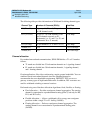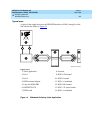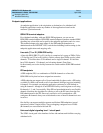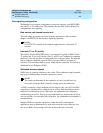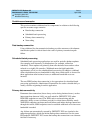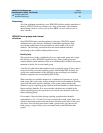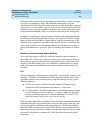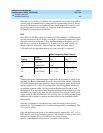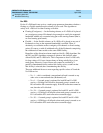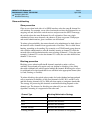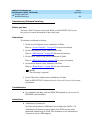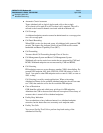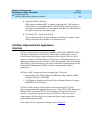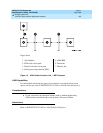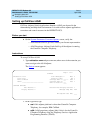
DEFINITY ECS Release 8.2
Administrator’s Guide
555-233-506
Issue 1
April 2000
Managing data calls
430Wideband Switching
15
N x DS0
For the N x DS0 multi-rate service, a trunk group parameter determines whether a
floating or a flexible trunk allocation scheme is to be used. The algorithm to
satisfy an N x DS0 call is either floating or flexible.
■ Floating (Contiguous) — In the floating scheme, an N x DS0 call is placed
on a contiguous group of B-channels large enough to satisfy the requested
bandwidth without any constraint being put on the starting channel (that is,
no fixed starting point trunk).
■ Flexible — In the flexible scheme, an N x DS0 call is placed on any set of
B-channels as long as the requested bandwidth is satisfied. There is
absolutely no constraint such as contiguity of B-channels or fixed starting
points. Of course, as with all wideband calls, all the B-channels comprising
the wideband call must reside on the same ISDN facility.
Regardless of the allocation scheme employed, the N x DS0 algorithm, like
the H11 and H12 algorithms, attempts to preserve idle facilities when
offered B, H0, and N x DS0 calls. This is important so that N x DS0 calls,
for large values of N, have a better chance of being satisfied by a given
trunk group. However, if one of these calls cannot be satisfied by a
partially-contaminated facility and an idle facility exists, a trunk on that
idle facility is selected, thus contaminating that facility.
There are additional factors to note regarding specific values of N and the
NxDS0 service:
— N = 1 — this is considered a narrowband call and is treated as any
other voice or narrowband-data (B-channel) call.
— N = 6 — if a trunk group is optioned for both H0 and N x DS0
service, a 384-kbps call offered to that trunk group is treated as an
H0 call and the H0 constraints apply. If the H0 constraints cannot be
met, then the call is blocked.
— N = 24 — if a trunk group is optioned for both H11 and N x DS0
service, a 1,536-kbps call offered to that trunk group is treated as an
H11 call and the H11 trunk allocation constraints apply.
— N = 30 — if a trunk group is optioned for both H12 and N x DS0
service, a 1,920-kbps call offered to that trunk group is treated as an
H12 call and the H12 trunk allocation constraints apply.



